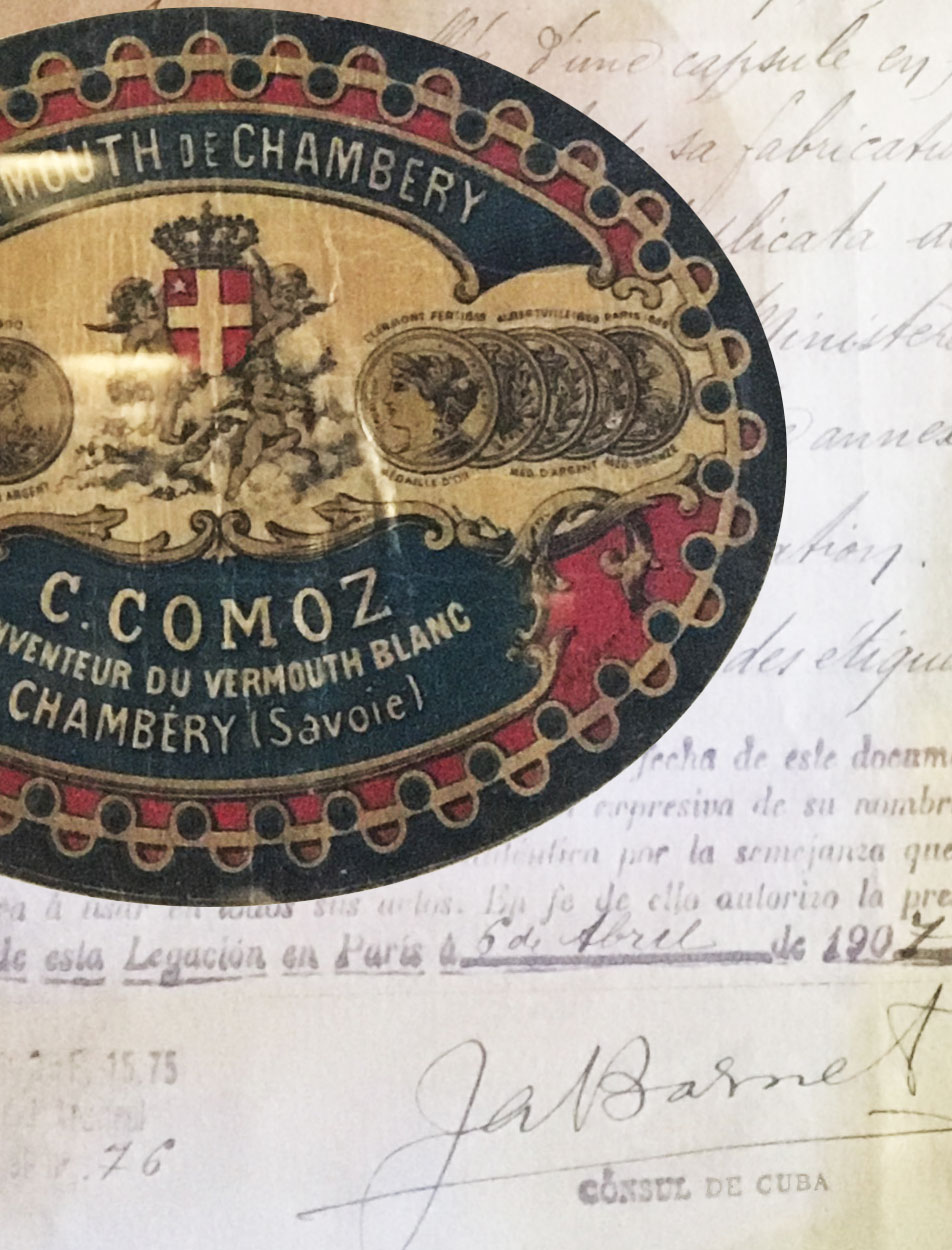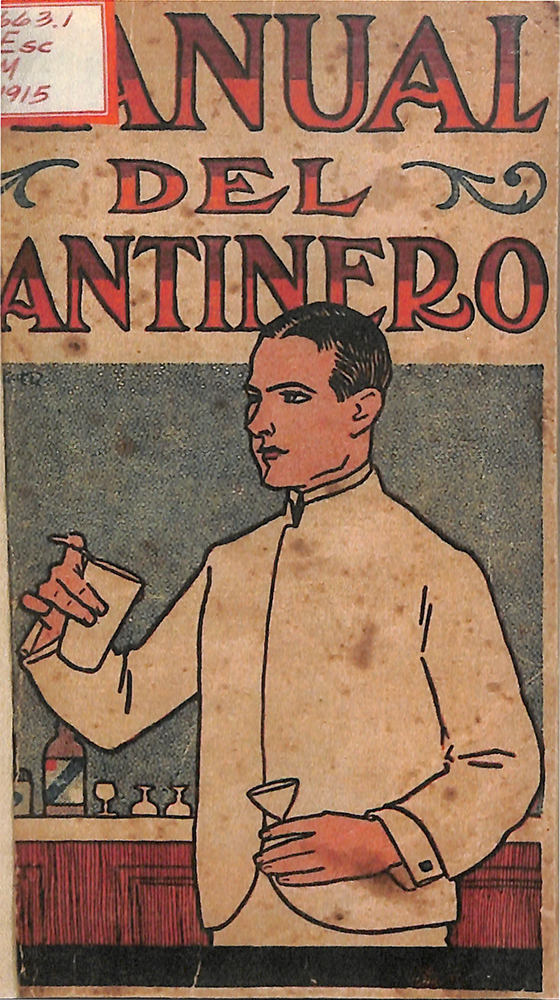Vermouth Comoz: The Missing Link
Few today have heard of Comoz. And yet, this venerable house in Chambéry was the first to market a clear, ‘blanc’ (white) vermouth and left an indelible mark on the history of the Cuban cocktail. Good news: Comoz is back, thanks to its former rival Dolin, and it’s quite an event.

For vermouth enthusiasts, the ‘blanc’ style can only mean two things: Martini Bianco (one of the best-selling vermouths in the world) and the historic Dolin Blanc. They probably know that blanc vermouth is as sweet as classic red but much less bitter; that its flavour profile is more about floral, citrusy and fruity notes than roots and spices, and that it has historically been more appreciated straight than in cocktails. Finally, if they are real connoisseurs, they may have heard that the style was born in Savoy, France, near Chambéry, before being reinterpreted quite successfully on the other side of the Alps, in Piedmont, Italy.
This is both a lot of information and very little: It tells us neither how Chambéry became synonymous with blanc nor about the flavour profile the product might have had originally. For the full story of blanc vermouth’s origins in Chambéry, we have to go back a little over two hundred years in time, when the Duchy of Savoy was administered from Turin in Piedmont—then the capital of the Kingdom of Sardinia (!). It was during these years, it is said, that one Joseph Chavasse, a distiller from Les Echelles, on the border with France, traveled to Turin and discovered vermouth. Once home, he began work on his first formula. After moving to Chambéry, the nearest big city, some time after 1815, he became the first vermouth maker in the region (the existence of the vermouth is attested as early as 1821). Upon his death, son-in-law Ferdinand Dolin took over the business—not without changing its name. Chambéry vermouth was at that time essentially a local product. Under the rule of the House of Savoy, vermouthiers in both Turin and Chambéry sold mostly within their own cities, as retail businesses. Over the years, liberalization opened things up, but Chambéry producers had to wait until the annexation of Savoy by France in 1860 for commercial expansion to become a reality.

Alongside Dolin, another house played a key role in this process: Comoz. Since the mid-1850s, the eponymous distillery had been offering a wide portfolio of liqueurs and distillates. Following Dolin lead, Comoz added a Chambéry vermouth to its portfolio. Around 1875, it reported production of about 100,000 litres per year—a negligible quantity if we compare it with Italian brands or Noilly-Prat, but just about enough to make them leaders in Chambéry.
The First Blanc
Upon founder Jean-Pierre Comoz’s passing in 1879, son Claudius decided to modernize the operation. Capitalizing on the fashion for colorless liqueurs made possible by improved filtration techniques, he introduced ‘blanc’ vermouth in 1881. Coincidentally or not, Chambéry vermouth boomed in the following years—in 1900, there were 17 producers. Parisian producers began to market imitation ‘Chambéry vermouth’ (an offense that would lead to the creation of the DO ‘vermouth de Chambéry’), while the Italians launched their own biancos in the early 20th century.

If this story is now largely forgotten, it is because Comoz did not survive the decline of the aromatized wine market. Claudius’ heirs abandoned production in the early 1970s. By then, Chambéry vermouth was residual, the market no longer merely dominated but quite simply crushed by Martini and, to a lesser extent, Cinzano.
Almost fifty years later, things have changed significantly. Vermouth is growing steadily and, thanks in particular to a very smart U.S. importer, Dolin has been ideally placed to benefit. Chambéry vermouth, in all its expressions, stands out, and the ‘blanc’ style seduces the best American cocktail bartenders. And it is this very importer, Haus Alpenz, that has teamed up with Dolin to relaunch Comoz. How is that possible? Well, there seems to be some sort of solidarity between Chambéry producers. When the last representatives of the Dolin family withdrew from the industry, they sold their brand and their recipes to relatives—who still control the company today. Similarly, when the last Comoz threw in the towel, he sold to his former rival. Dolin is uniquely placed to offer an authentic version of this historic vermouth.
The magnificent thing about this resurrected Comoz is that it confirms my suspicions regarding the first blancs. Today, most blancs are made with 130 to 140 grams of sugar per litre—much like most standard reds—and, Dolin excepted, the nose is dominated by vanilla and more-or-less balanced pastry notes. Many are too sweet, with unbalanced botanical mixes. According to my research, the original Chambéry blanc vermouth most certainly offered a fresh palate, matched with clear notes of alpine herbs and a sugar level that would place it somewhere between dry vermouth à la Noilly (30 g per litre nowadays, 55 g then) and today’s blancs. An analysis carried out in 1878 placed Comoz at 82 g per litre. This is roughly in line with the new Comoz.
From the Alps to Cuba
But let’s forget about measures. A tasting of Comoz reveals a product that recalls the balance and elegance of Dolin Blanc, with some important differences. Rather than notes of fruits such as apricot or peach, we get hints of cherry. The floral and citrus notes are less obvious, with a much more notable presence of wormwood, used for its aromatic character rather than for its bitterness (present but discreet). An alpine and non-balsamic vermouth: this is precisely what we expected from a formula created right at the point when the category had definitely left the medicinal world without completely turning its back on its origins.

Comoz Blanc is not only interesting for lovers of good vermouth (ever more numerous) or of its history (unfortunately still an endangered species). In addition to playing an important role in the development of its category, the brand has also left its mark on the history of the cocktail. This may seem strange because, until recently, blanc vermouth held very little interest for mixologists. After the Second World War, the vermouthiers of Chambéry mostly exported Italian-style vermouths (for Manhattans) and dry ones (for Dry Martinis). Comoz is a striking case: Under contract with an American importer, the company marketed Italian-style and dry vermouths in the United States under the name of Boissière. But there’s no trace of a blanc expression, even though its invention was mentioned in some Boissière ads. (Note that ever since Comoz first halted production, the American trademark owner of the Boissière brand has had it made in Italy—40 years later, it is still produced there and sold in the United States.)
The initial charm of Chambéry for the American public resided in the filtration technique that local producers had also decided to apply to dry vermouth. Unlike Noilly Prat, these dry Savoyard products enabled bartenders to mix colourless Dry Martinis, as preferred by midcentury American clientele.

Still, there was a brief period when Chambéry blanc was indeed a crucial ingredient for bartenders. It started in Cuba in the 1910s, where cantineros (local bartenders) created the style’s one and only true classic: the Presidente. Today, the drink is often made, in the worst case, with dry vermouth or, in the best case, with Italian red vermouth, which is why it’s generally described as either a Cuban Martini or a Cuban Manhattan. However, the first recipe, as published in 1915, seems to have been inspired by the Martinez: It calls for two parts Chambéry blanc vermouth and one part light rum. Touches of grenadine, curaçao and bitters are also added. A few years later, at the legendary Floridita, the recipe morphed into its canonical form: equal parts of the two main ingredients, a little grenadine, a little curaçao but no bitters. When the authentic genealogy of the cocktail was revealed by historians in recent years, discerning bartenders turned to Dolin Blanc to mix Presidentes estilo años 20. This excellent version allowed the Presidente to reclaim, at long last, some of its fame. With Comoz, drier and more herbaceous, back on the scene, new possibilities emerge. Indeed, Dolin doesn’t appear to have really made much of an impression in Havana until the 1930s. The first blanc vermouth sold in Cuba seems to be its competitor; Comoz landed there in 1911. Mixologists obsessed with historical correctness have their work cut out for them—but they are not alone. Indeed, blanc vermouth’s long decades in the wilderness offer ample virgin territories for the creativity of any bartender. This relaunched Comoz is therefore valuable for three reasons: its intrinsic qualities, its cocktail potential and, for a very select club of enthusiasts, what it tells us about an essential aspect of the history of forgotten liqueurs and spirits. This spirituous dodo has been brought back from extinction.
Adapted from an article first published in WhiskyMag.fr on August 29, 2018
